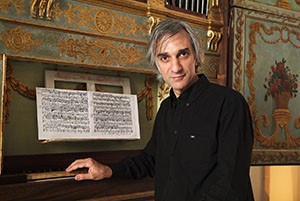 Friday, 28 October, 9.30, p.m.,
Friday, 28 October, 9.30, p.m.,
Igreja de São Martinho (Funchal)
Diminution in the 17th century in the Cathedrals of the Mediterranean
Tiago Simas Freire, cornetto
João Vaz, organ
Diminution in the 17th century in the Cathedrals of the Mediterranean
The golden age of the cornetto occurred mainly in the North of Italy between 1580 and 1630, but its use spread throughout Europe and over the course of more than two centuries. Every cathedral, noble chapel and court orchestra would obligatorily include good cornettists amongst their instrumentalists. In the Iberian Peninsula the cornetto appears in Spanish cathedrals from the beginning of the second half of the 16th century, and in Portugal the first mention dates from 1593, in Évora Cathedral, where it would remain in use until at least 1725. Nowadays, the cornetto is easily associated by audiences with the Toccata that opens Monterverdi’s Orfeo. But what other repertoire might be performed specifically by cornettists? This programme has been constructed as something of a panorama in dialogue between the cornetto and the organ, its inseparable accomplice. In the service of various ecclesiastical institutions, the cornetto would be the ornament of innumerable canzonas and sinfonias. In addition, the virtuoso repertoire for the cornetto was above all “diminutions” or “glosas”, that is, soloistic improvisations on the polyphonic repertoire. Many musicians recorded this art in didactic treatises, amongst them the cornettist Girolamo della Casa, who took over the direction of the instrumental ensemble in the service of the ducal chapel of St. Mark in Venice. In fact, the art of the cornettist (and of any instrumentalist) was, at this time, the imitatation of singers. Giovanni Bovicelli, a sopranist in the service of the Sistine Chapel, left us a treatise in which he describes the vocal art in detail. Finally, the functions of the cornettist included the performance of arias and the “smooth melodies” of chamber music, as well as suites of music for dancing at the frequent balls. Even though some ten cantatas by Johann Sebastian Bach make mention of their use, the cornetto would fall into disuse from the middle of the 18th century, being replaced by the violin in virtuoso music, by the oboe in sacred music and by the trumpet in ceremonial music.
Tiago Simas Freire
Claudio Monteverdi (1567-1643)
¬ Tocata e ritornello
(L’Orfeo, 1609)
Girolamo Frescobaldi (1583-1646)
¬ Canzon seconda
¬ Toccata per l’elevatione * (Fiori musicali, 1635)
Bartholomeu Trosilho (1500-1567)
¬ Circumdederunt me
(Diminuição de Tiago Simas Freire)
Giovanni Gabrieli (c.1554-1612)
¬ Toccata del secondo tono *
(Il Transilvano, 1625)
Thomas Crecquillon (1505-1557) / Giovanni dalla Casa (?-1601)
¬ Petite fleur coincte et jolie (chanson glosada)
(Il vero modo di diminuir, 1584)
Antonio Valente (1520-1581)
¬ Lo ballo dell’intorcia *
Andrea Falconiero (1585/6-1656)
¬ La suave melodia & su corrente
Anónimo (Itália, séc. XVII)
¬ Aria con variationi *
(Ms. 964, Arquivo Distrital de Braga)
Cipriano di Rore (1515/6-1565) / Giovanni Bovicelli (1550-1594)
¬ Anchor che col partirò (madrigal glosado)
Bernardo Storace (séc. XVII)
¬ Balletto *
(Selva di varie compositioni, 1664)
Salomone Rossi (c.1570-1630)
¬ Correnta
¬ Brando
¬ Gagliarda
Claude Gervaise (1525-1583)
¬ Pavane
¬ Gaillarde
¬ Bransle de Bourgogne
¬ Tourdion
(Livres de danceries, 1547-1557)
* organ solo
Participants
|
With three master’s degrees (in architecture, recorder and historical cornetto) and a doctorate underway, Tiago Simas Freire is moved by a lively spirit and fascinated by human artistic creation. His studies at the early music departments of ESMAE in Oporto, ESMUC in Barcelona and CNSMD in Lyons, he had the opportunity to study with great musicians who have become personal guides: recorder with Pedro Sousa Silva, Pedro Memelsdorff and Pierre Hamon; cornetto with William Dongois and Jean Tubéry. His doctoral research (CNSMD in Lyons / University of St Etienne / University of Coimbra) is in performance practices in unpublished Portuguese musical manuscripts from the 17th century. In 2012 and 2015 he was awarded an ADAMI grant. He performs regularly with various ensembles, such as La Fenice (Jean Tubéry), Concerto Soave (Jean-Marc Aymes) and Cappella Mediterranea (Leonardo Garcia-Alaron). He is artistic director of Capella Sanctae Crucis, with which he has presented his doctoral work, and which is currently preparing its first CD. Tiago Simas Freire has given seminars at ESMAE and at the Conservatoires of Aveiro and Coimbra. He has given lectures at the Ambronay Cultural Centre (France) and at the University of Coimbra. He is assistant to William Dongois in a research project at the Haute-Ecole de Musique in Geneva. Since 2014 he has taught cornetto and ornamentation on the ESMAE/ESML International Early Music Courses. |
|
Born in Lisbon, João Vaz graduated in organ from the Higher School of Music in Lisbon, studying with Antoine Sibertin-Blanc, and from the Higher Conservatoire of Aragon, in Zaragoza, where he studies with José Luis González Uriol, on a scholarship from the Gulbenkian Foundation. He has a doctorate in music and musicology from the University of Évora, where his thesis, on Portuguese organ music from the end of the ancien regime was supervised by Rui Vieira Nery. He has been extremely active internationally, both as a performer and as a teacher on organ courses, and as a jury member in competitions. He has made more than ten solo recordings, significant among them those made on historical Portuguese organs. As performer and musicologist he has paid particular attention to Portuguese sacred music, founding in 2006 the ensemble Capella Patriarchal, which he directs. His work in transcribing and editing, which he has been published in Portugal and Spain, covers works preserved in various Portuguese libraries and archives. He currently teaches organ at the Higher School of Music in Lisbon. He is artistic director of the Madeira Organ Festival and of the concert series featuring the six organs of the Basilica of the National Palace of Mafra (for the restoration of which he was a permanent consultant) and of the historical organ of the Church of São Vicente de Fora in Lisbon, of which he became titular organist in 1997. |
Notes about the organ
 Church of São Martinho, Funchal
Church of São Martinho, Funchal
The oldest documental reference it has been possible to find concerning the existence of a pipe organ at the parish church of São Martinho goes back to 1806. According to a record set down by the treasurer of the Confraria de Nossa Senhora do Rosário (Fraternity of Our Lady of the Rosary), an organist was contracted in 1806 to tune the organ, and there are other later records referring to maintenance work.
In the record of expenditure for the year 1862, to be found in the Accounts Book (1834-1877), the vicar José Rodrigues de Almada noted down the sum of 200,000 réis for payment of the new organ, specifying that 150,000 réis were contributed by the Benefice of the church; 40,000 réis was credited from the amount paid for the old organ and 10,000 réis was donated, thus making up the real price of the instrument.
From this source it has proved impossible to determine the conditions for its transport, or where it was acquired. What is certain is that in 1863 the organ was already in this church, for that year Father João G. de Noronha was contracted to tune the said instrument, receiving 2,000 réis for his work.
With the transfer of the parish to the newly consecrated church in 1918, the organ was then taken there, where it continued to function until 1934. According to the records found in the Accounts Book (1877-1954), the organ underwent successive maintenance works, the most expensive being in 1879 (a payment of 38,000 réis to Nuno Rodrigues) and, especially, in 1916, because it was very out of tune and had a number of technical problems.
As an instrument to accompany and enhance divine worship, the organ of the church of São Martinho will have participated in various solemnities, and in the year 1917 there is a record in the Accounts Book of receipt of 10.700 réis “arising from the contribution of the organ to the festivities”.
Manual (GG, AA, C-f´´´)
Stop Diapason Bass (GG-b)
Stop Diapason Treble (c´-f´´´)
Principal
Flute
Dulciana
 Tiago Simas Freire
Tiago Simas Freire João Vaz
João Vaz